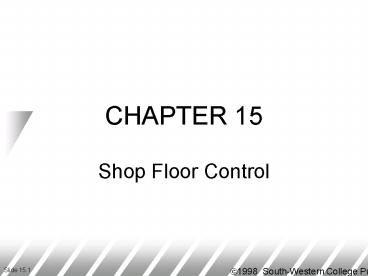Shop Floor Control - PowerPoint PPT Presentation
1 / 18
Title:
Shop Floor Control
Description:
CHAPTER 15 Shop Floor Control 1998 South-Western College Publishing Chapter Outline I. Introduction II. Shop Floor Control in Continuous and Repetitive Operations III. – PowerPoint PPT presentation
Number of Views:1015
Avg rating:3.0/5.0
Title: Shop Floor Control
1
CHAPTER 15
- Shop Floor Control
ã1998 South-Western College Publishing
2
Chapter Outline
- I. Introduction
- II. Shop Floor Control in Continuous and
Repetitive Operations - III. Shop Floor Control in Intermittent Job
Shop Operations - IV. Scheduling Intermittent Job Shop Processes
- V. Data Collection and Order Disposition
- VI. Innovative Control Theory of Constraints
3
Shop Floor Control involves determining a
production plan and routing for each
manufacturing order, releasing that order to the
production or service facility, tracking its
progress and reporting its status when needed,
and measuring the performance of the facility
based upon the timely, cost effective completion
of those orders.
4
Shop Floor Control in Continuous Process
perations
Objectives Maintaining linearity by producing
a consistent product a t a consistent rate of
production. Decision areas Choice of
technology, and replacement and maintenance of
the technology. Key Activities Routine
reporting of system status and prediction of
ability of system to meet order requirements
on-time.
5
Shop Floor Control in Repetitive Operations
Objectives Increase repetitiveness through all
phases of the system to make the system more
predictable and easier to manage. Decision areas
Reduce variability of the product and increase
flexibility of the system. Key Activities
Routine reporting of system status and prediction
of ability of system to meet order requirements
on-time.
6
Shop Floor Control in Job Shop Operations
Objectives Meeting job due dates while
maintaining high utilization of
resources. Decision areas Job due dates and
routings. Key Activities Determining lead times
for orders, determining routings of jobs, and
determining job release times.
7
Shop Floor Control Terminology
- Job or Order - a unit of production that follows
some sequence of operations. - Production Lot - the number of units in the order
that are produced between process setups. - Operation Processing Time - the estimated time
that is required at an operation. - Total Processing Time - the sum of the operation
processing times for a job.
8
Shop Floor Control Terminology
- Planned Lead Time - the estimated time it will
take to complete an order including processing
time and delays. - Flow time or Cycle Time - the time that an order
actually takes to flow through the shop. - Completion Date - the actual time when an order
is completed.
9
Performance Measures in Job Shop Floor Control
- Work-in-process inventory
- orders that have been released but not yet
completed - Throughput
- total volume of output form a process
- Utilization
- percentage of time that resources are busy
10
Work-in-process inventory should be reduced
because...
- it represents a commitment of raw material and
processing time that has not yet generated any
cash flow from the customer. - it is an indication of long flowtimes or cycle
times. - it contributes to shop congestion and confusion.
11
Methods of Reducing Non-value Adding Activities
- Reduce Setup Times
- Reduce Queue Times
- Reduce Material Handling
12
Sequencing is the process of prioritizing jobs
that are waiting to be processed.
Common sequencing or dispatching rules
- First Come, First Served
- Shortest Processing Time
- Earliest Due Date
- Slack Time Remaining
- Critical Ratio
13
Common Measures of Job Shop Performance
- Average Flowtime
- Average Number of Jobs in the System
- Average Lateness
- Maximum Lateness
14
Johnsons Rule provides an optimal solution to a
fixed sequence, two machine problem.
15
Johnsons Rule Steps
1. Identify the minimum operation processing
time for the unsequenced jobs. 2. If the minimum
time is for the first operation, place the job as
early as possible in the sequence. If the
minimum time is for the second operation, assign
it to the latest unassigned position in the
sequence. 3. Break ties judiciously. 4. Repeat
from step 1.
16
Theory of Constraints is about identifying
bottleneck operations, or constraints, which have
fixed capacity and cannot be rushed. These
bottleneck operations are critical to
determining the throughput of the manufacturing
system.
17
TOC Process Steps
Step 1 Identify the systems constraints. Step
2 Decide how to exploit the systems
constraints. Step 3 Subordinate everything else
to the decisions made in Step 2. Avoid keeping
non-constraint resources busy doing unneeded
work. Step 4 Elevate the systems constraints.
If possible, reduce the effects of the
constraints. Step 5 If a constraint is relaxed
in Step 4, go back to Step 1. Do not let inertia
become a constraint.
18
TOC Performance Measures
- Throughput - the rate at which the system
generates money through sales. - Inventory - the money invested in things it
could or plans to sell. - Operating expense - any money spent in the
transformation process which converts inventory
into throughput. - Goal Maximize throughput while minimiz-ing
inventory and operating expense.































